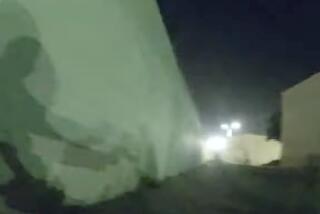Deputies’ Credibility Took a Beating at Latino Project : Sheriff: The Ramona Gardens standoff turned into the Rodney G. King episode of the department.
- Share via
The road slanting into Ramona Gardens from the San Bernardino Freeway runs by a haphazard sprawl of frame houses and factories, then curves past the housing project’s brick dormitories. By day, Murchison Street is a road not taken, save for the poor Latino families who live there, the social workers and priests who visit and the police who cruise slowly past.
It is even more deserted at night. Hillside houses are sealed and dark. Mill yards are strewn with idle machines and ghostly piles of scrap. The street dead-ends near a casket factory.
Before dawn on Aug. 3, Murchison came alive.
Minutes after a Los Angeles County sheriff’s deputy fatally shot an unarmed gang member inside Ramona Gardens, sheriff’s and Los Angeles police squad cars began barreling up and down Murchison’s steep grades, bound for a command post where scores of black-and-whites and unmarked police cars parked in darkness.
For five tense hours that morning, police and Latino residents of the Los Angeles housing project drew perilously close to a state of war. Ramona Gardens was quarantined like a prison lock-down. Deputies stood guard with shotguns and assault rifles at sentry points around the project. Residents were unable to leave, outsiders unable to enter.
“Parents, elderly people were calling and saying that they felt pressed in for no reason,” said Father Juan Santillan, the priest at neighboring St. Lucy’s Church. “That was what helped keep the tension level so high.”
The Ramona Gardens standoff was a watershed for the Sheriff’s Department--in a sense, its Rodney G. King episode. In much the same way that the King affair subjected Los Angeles Police Department officers to intense national scrutiny, the Ramona Gardens confrontation exposed sheriff’s deputies to harsh public questions about their judgments and relations with the minority communities they patrol.
As one LAPD patrol officer on the scene that morning put it: “All I know is that this is a sheriff’s operation. I say, let them have their fun. This is their show. This time, we’re not going to be the bad guys.”
The slaying of Arturo (Smokey) Jimenez by Deputy Jason Mann was the first in a spate of fatal shootings by deputies--each one bringing mounting pressure for reform. In the weeks that followed, Ramona Gardens residents, embittered by their treatment, united with members of Jimenez’s Big Hazard gang to attend his funeral and contribute to his family’s legal fund. They lobbied politicians and the media to force an independent probe of the shooting, persuading the district attorney’s office to open an investigation.
Such responses might have been unthinkable a year ago. But the King beating has altered the political landscape, conditioning an entire population to view law enforcement’s credibility with more skepticism.
A sheriff’s spokesman would justify deputies’ actions that night by saying that a riot had almost broken out. “About 200 to 300 people came out, were very belligerent and were throwing rocks and bottles at us,” the spokesman, Larry Mead, said. In fact, while some rocks and bottles were thrown, there was no near-riot, as sheriff’s officials would later concede.
“The residents, in general, were not riotous and that with few exceptions were cooperative with law enforcement,” another spokesman acknowledged several days later.
What did happen in the pre-dawn hours of that summer morning at Ramona Gardens illustrated how the mutual suspicions and fears that sometimes fester between a community and a police force can inflame an already volatile situation.
Emergency scanners were silent, channels of dead air, when a male voice came over a city paramedic frequency about 2 a.m. The speaker was a paramedic, informing a dispatcher that a man had been shot by a deputy “near City Terrace.” The shooting victim was beyond hope. “We’ve got him in the ambulance,” the medic said.
The ambulance that contained Jimenez was parked among a cluster of fire vehicles, where more than 50 sheriff’s deputies and two dozen LAPD officers had established a command post several blocks outside the World War II-vintage housing project. The ambulance’s rear doors were still open, revealing a white sheet pulled over the body. A running shoe protruded from underneath the sheet.
Although the circumstances remain unclear, Jimenez was shot three times in the chest sometime after 1:35 a.m. Two deputies had driven into the project, which is in the LAPD’s jurisdiction, while pursuing a car seen speeding in county territory. Surrounded by gang members and their girlfriends, Jimenez and Deputy Mann became involved in an argument as they stood face to face in a commons near the project’s eastern edge.
The gang members would later insist that Mann fired for no reason and without warning. A sheriff’s spokesman would contend that the deputy was protecting himself from Jimenez, who allegedly had grabbed another deputy’s flashlight and was about to assault them.
Briefly, in those first confusing minutes, gang members pelted the deputies with rocks and bottles. Several youths drove a picket fence post through a squad car window, according to one witness.
LAPD officers, summoned to the scene to bolster the contingent of arriving deputies, tried to calm the angry crowd of about 75 gang members and residents. They appeared to be having success, keeping the crowd concentrated near the immediate crime scene, said Jose Miranda, who watched from an apartment nearby.
But despite the fact that the crowd had not swelled or become more menacing, the deputies reacted as if the situation was deteriorating. Three blocks from the shooting scene, at the project’s northern edge--where there had been virtually no unrest--two deputies crouched behind their patrol car as if expecting incoming fire. One wielded a shotgun, the other held a pistol.
Overhead, a police helicopter spun in a shuddering gyre, training a 50-million candlepower searchlight down into the project. Dirt and trash, illuminated by the searchlight, spun into small vortexes whenever the craft dipped down toward the ground.
A deputy, as he scurried back from his car, cradled a pump-action department-issue shotgun, keeping his finger taut on the trigger guard.
“I would keep well back,” he said. “This is as close to war as you’re going to get.” He ran, crouching, back to the squad car. A bottle burst on the pavement about 100 yards away, tossed from one of the project apartments. The deputy flinched, then seemed to relax slightly after several minutes passed without the sound of shattering glass.
When the coast seemed clear, he returned with a further warning: “We’ve got deputies taking shots. We don’t know who’s got guns and who doesn’t. They’re starting to move our way and that could be trouble.” Actually, as deputies would later report, no shots had been fired.
Moments later, four Ramona Gardens residents appeared on the other side of the street, striding through the commons toward the deputies’ car. The four residents--a fat teen-age boy, a woman in a long bathrobe and two adolescent girls--walked nonchalantly, almost jauntily, unaware that the deputies perceived them as a threat. As they began to cross the street toward the squad car, the deputies leaped into shooting stance, training their flashlights and guns on the quartet.
“Get back,” the one with the shotgun yelled. “Do not come any closer, do you hear! Get back now!”
The woman waved her hands and tried to shout over the helicopter’s roar. “The trouble is back there, not up here,” she cried, referring to the crime scene three blocks away. After a second warning, she and the others turned back, huddling in the commons briefly before disappearing into the project.
Residents repeatedly tried to leave that section of the project, where the only evidence of trouble was the sight of armed deputies. Two bearded men trying to drive out were ordered to drive back in. A car on its way down Alcazar spun into reverse when deputies leveled their guns at the driver.
“This is nuts, man,” said Mike Cardenas, 17, a spike-haired youth who had driven down toward the project from a hillside home. “I called a friend of mine, a Hazard (gang member) who lives inside, and he says it’s like a prison in there. He said he tried to get out three different times and they stopped him with guns. Wow.”
Some project residents were too frightened by the deputies to take their chances outside. From his project window, Jose Miranda worried that “the cops had gone crazy on us.”
Miranda had invited several friends over the night before. They tried to leave shortly after 2 a.m., but were not allowed to. “They couldn’t go home,” he said. “The guy across the way told me the deputies put a gun to his head as he was coming back from a party.”
Even the commander of the neighboring Los Angeles Police Hollenbeck Division, Capt. Robert Medina, later expressed bafflement at the way deputies cordoned off the project. “I can’t imagine,” he said, “why they would have been doing that.”
Medina, who was at the command post that night coordinating with sheriff’s officials, said that the “tremendous volatility and emotion” among gang members and other residents spurred him to send his own officers to protect the immediate crime scene. Reluctant to criticize the sheriff’s performance, he speculated that it might have not been the “command, but individual officers” who prevented residents from entering and leaving.
A sheriff’s spokesman later explained that “when you have a crime scene, there might be anywhere from a block to an acre that we may need to rope off. We’ll shut everything down in a situation like that.”
Capt. Ramon Sanchez, the head of the East Los Angeles station, the man who made the decisions at the command post that morning, would say only that the deputies “were maintaining the crime scene” and disputed reports that the entire project had been sealed. Asked why the crime scene appeared to be extended as far as three blocks from the shooting site, he said brusquely: “I can’t comment on that.”
It was not until 5 a.m. that deputies visibly relaxed their sentry-like stance around Ramona Gardens. Some returned to the East Los Angeles station while others waved through residents who needed to pass.
In the light of dawn, the northern edge of Ramona Gardens showed no trace of damage from the night’s confrontation. Men came out to wash their cars, just as they do every weekend. Wives strung their laundry on clotheslines in the project commons. Children scampered around the pastel-colored dormitories.
But in the days that followed, as they gathered in their doorways to recount the events of that morning, the people of Ramona Gardens talked of an intangible damage they felt.
“It used to be just the kids that always complained about the police,” said Christina Sanchez, a middle-aged resident. “Now the older folks and the parents know this kind of thing can happen to them too.”
It felt as though they were enemies in their own homes.
More to Read
Sign up for Essential California
The most important California stories and recommendations in your inbox every morning.
You may occasionally receive promotional content from the Los Angeles Times.










